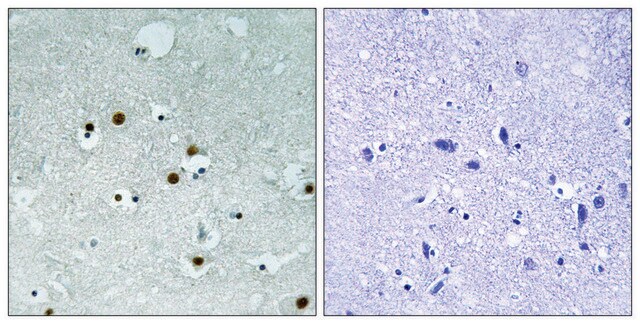05-689
Anti-HP1α Antibody, clone15.19s2
clone 15.19s2, Upstate®, from mouse
Synonim(y):
Antigen p25, HP1 alpha, HP1Hs alpha, Heterochromatin protein 1 homolog alpha, chromobox homolog 5 (Drosophila HP1 alpha), chromobox homolog 5 (HP1 alpha homolog, Drosophila), heterochromatin protein 1-alpha
About This Item
Polecane produkty
pochodzenie biologiczne
mouse
Poziom jakości
forma przeciwciała
purified immunoglobulin
rodzaj przeciwciała
primary antibodies
klon
15.19s2, monoclonal
reaktywność gatunkowa
mouse, vertebrates, human
producent / nazwa handlowa
Upstate®
metody
ChIP: suitable
immunocytochemistry: suitable
immunohistochemistry: suitable
immunoprecipitation (IP): suitable
western blot: suitable
izotyp
IgG1
numer dostępu NCBI
numer dostępu UniProt
Warunki transportu
wet ice
docelowa modyfikacja potranslacyjna
unmodified
informacje o genach
human ... CBX5(23468)
Opis ogólny
Specyficzność
Immunogen
Zastosowanie
A previous lot of this antibody has been reported by an independent laboratory to detect HP1a in NIH/3T3 nuclei (Ayyanathan, K., 2003).
Immunoprecipitation/Chromatin Immunoprecipitation:
A previous lot of this antibody has been reported by an independent laboratory to immunoprecipitate HP1α from nuclear extracts and formalin-cross-linked chromatin (Ayyanathan, K., 2003).
Epigenetics & Nuclear Function
Chromatin Biology
RNA Binding Protein (RBP)
Jakość
Western Blot Analysis:
0.5-2 µg/mL of this lot detected HP1α protein in acid-extracted HeLa cell lysates.
Opis wartości docelowych
Powiązanie
Postać fizyczna
Przechowywanie i stabilność
Handling Recommendations:
Upon receipt, and prior to removing the cap, centrifuge the vial and gently mix the solution. Aliquot into microcentrifuge tubes and store at -20°C. Avoid repeated freeze/thaw cycles, which may damage IgG and affect product performance. Note: Variability in freezer temperatures below -20°C may cause glycerolcontaining solutions to become frozen during storage.
Komentarz do analizy
HeLa, NIH/3T3 and COS cell lysates.
Inne uwagi
Informacje prawne
Oświadczenie o zrzeczeniu się odpowiedzialności
Nie możesz znaleźć właściwego produktu?
Wypróbuj nasz Narzędzie selektora produktów.
Kod klasy składowania
12 - Non Combustible Liquids
Klasa zagrożenia wodnego (WGK)
WGK 1
Temperatura zapłonu (°F)
Not applicable
Temperatura zapłonu (°C)
Not applicable
Certyfikaty analizy (CoA)
Poszukaj Certyfikaty analizy (CoA), wpisując numer partii/serii produktów. Numery serii i partii można znaleźć na etykiecie produktu po słowach „seria” lub „partia”.
Masz już ten produkt?
Dokumenty związane z niedawno zakupionymi produktami zostały zamieszczone w Bibliotece dokumentów.
Nasz zespół naukowców ma doświadczenie we wszystkich obszarach badań, w tym w naukach przyrodniczych, materiałoznawstwie, syntezie chemicznej, chromatografii, analityce i wielu innych dziedzinach.
Skontaktuj się z zespołem ds. pomocy technicznej





